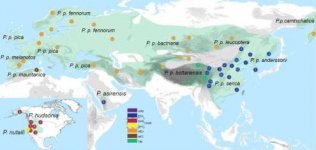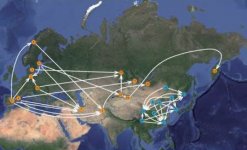Peter Kovalik
Well-known member

Kryukov A.P., Spiridonova L.N., Mori S., Arkhipov V.Y., Red'kin Y.A., Goroshko O.A., Lobkov E.G. & Haring E., 2017. Deep phylogeographic breaks in magpie Pica pica across the Holarctic: concordance with bioacoustics and phenotypes. Zool. Sci. Early view
Abstract
We examined sequences of the mitochondrial control region in magpies (Pica pica) from the entire distribution range and found deep genetic splits into four major lineages: (1) group West (Europe-Siberia), (2) group East (southern Far East), (3) P. p. mauritanica (North Africa), and (4) P. p. hudsonia (North America). These lineages show a geographic pattern corresponding to known subspecies or subspecies groups. Genetic variation within the widely distributed group West is low and neutrality tests supported a recent expansion scenario. The haplotypes from Kamchatka, representing a separated sublineage with clear affinity to the European-Siberian group, are almost identical, implying a recent bottleneck. Group East contained two subclades without clear geographic pattern, presumably due to admixing of populations that had diverged in Pleistocene refuges. The homogeneity of the Kyushu population supports historical reports of introduction of the species from Korea. In contrast, the high variation in the recently established Hokkaido population might be supported by ongoing invasion from several populations of the Far Eastern mainland. Bioacoustic data based on chatter call differentiate groups of subspecies and reflect phylogeographic patterns, i.e., mitochondrial lineages. Furthermore, we report the fast spreading of P. p. jankowskii towards the west along the upper Amur River, and a slower shifting of P. p. leucoptera in the opposite direction thus yielding a new contact zone. Overall, our data support a scenario of divergence in geographic isolation, but the ongoing expansion of distribution ranges may lead to major changes in phylogeographic patterns.
Here
TiF Update May 31, 2017
Pica Magpies: After reading Kryukov et al. (2017) and examining the treatment in the HBW-Checklist (del Hoyo and Collar, 2016). I have implemented the following splits. The Oriental Magpie, Pica bottanensis, has been split into Himalayan Magpie, Pica bottanensis (monotypic), and Oriental Magpie, Pica serica. Moreover, the Eurasian Magpie, Pica pica, has been split into Maghreb Magpie, Pica mauritanica (monotypic), Asir Magpie, Pica asirensis (monotypic), and Eurasian Magpie, Pica pica (all other subspecies).









